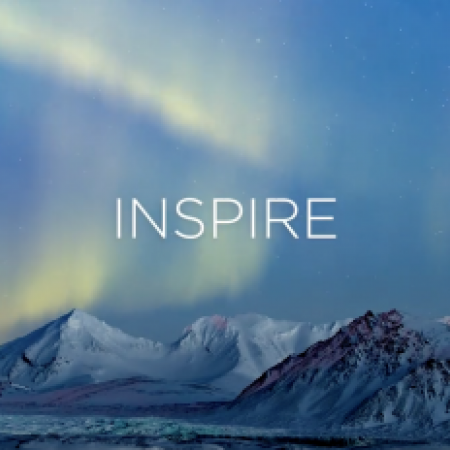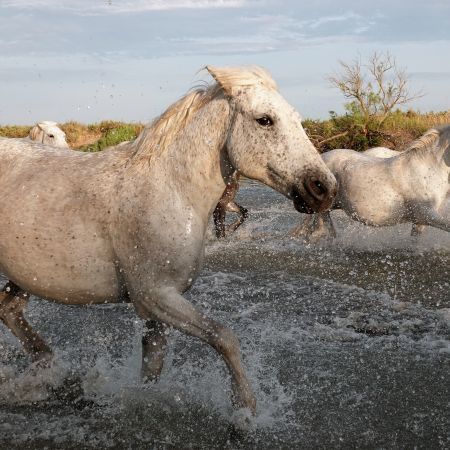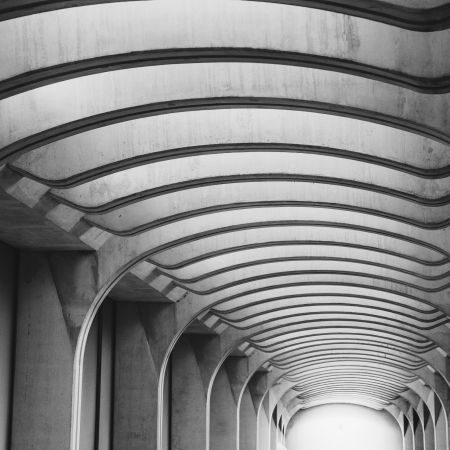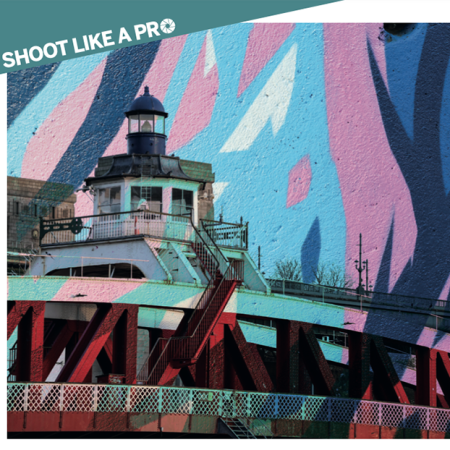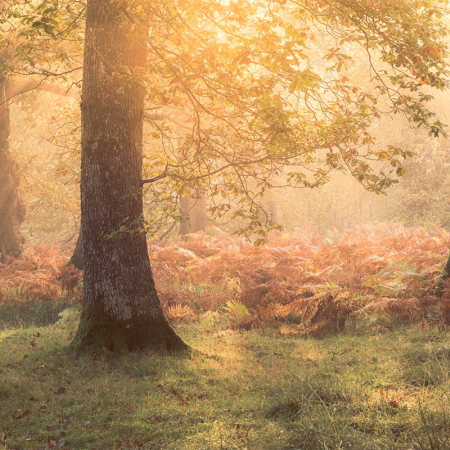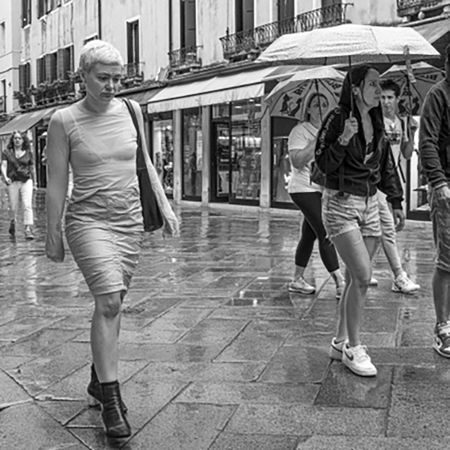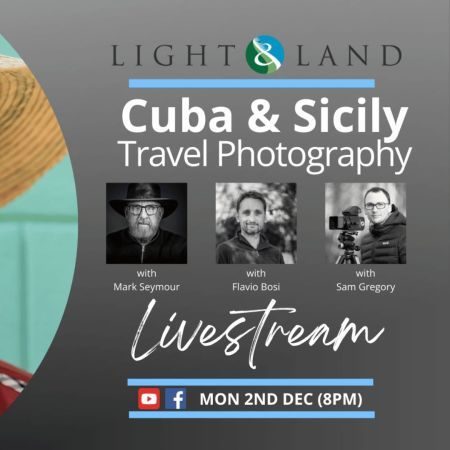Light & Land
Review: Botswana
6th September 2018
In August, Ben Osborne took a small group of four to Botswana for a landscape and wildlife tour. Here he shares his insights into the tour...

Day 1
After trouble-free international flights and transfers, we meet Andrew, our safari guide, at the small and welcoming airport in Maun. All bags have arrived safely (a good start) so we load the vehicle and head straight out to camp along dirt roads stippled with the tracks of elephant and numerous antelopes. We pass small farmsteads along an all-too-short 30 km of tarmac after which the road becomes rougher and dustier until we reach the South Gate entrance to Moremi National Park. From here we travel single track dirt roads through seemingly endless Mopane scrub until we suddenly emerge into a forest of huge trees with open clearings populated with herds of impala and zebra. By now the sun is low in the sky and the soft evening light creates a “Garden of Eden” atmosphere.
As dusk falls, we arrive at camp, to be warmly welcomed by the staff who whisk us off into the near darkness and show us to our tents. The camp is situated on the edge of a lagoon from which the sounds of hippos and frogs grow in volume as the evening progresses. Soon we are sitting round a fire on the edge of the lake, drink in hand. A quick scan with the torch shows huge, shadowy figures moving in the swampy vegetation in front of us. Luckily, the munching sounds suggest that our noisy neighbours are more intent on scooping up their dinner than disturbing life in camp. There are no fences here. If hippos or any other animals want to stroll through camp, they can.

This relaxing scene is interrupted by the announcement that dinner is ready. Cooked on an open fire and using the most basic of equipment, every meal is a treat, covering a variety of Western, Mediterranean, Asian and African dishes, all cooked to perfection and accompanied by some very good South African wines. The only minor disturbance tonight is when Andrew “senses” an animal near the table and a brief scan with his torch reveals a solitary hyena wandering through camp looking for scraps. (We spend much of the tour wondering how on earth Patrick, the cook, manages to deliver these stunning meals so we eventually ask for a kitchen tour - see Day 8 below!).
Day 2
5.30 a.m. awakening. A quick splash with the warm water that has just been delivered to the canvas basin outside the front of the tent. Tea, coffee, porridge, toast, grab the kit, climb into the 4-wheel drive safari vehicle and off we go. Slowly, slowly is the key. Eyes peeled in the half-light of pre-dawn, senses alert for any movement in the scrub which might give away the presence of any lingering cat that might be heading “home” after a nights hunting. No luck at first and the Impala are all looking far too relaxed, anyway – a sure sign that predators aren’t present. But the possibility is always there.

The forest eventually gives way to open grassland. Impala and zebra drift through the long grass while a warthog family panics and they run off with tails erect. Something must have moved. We scan the scene but can’t see anything. Typical warthogs.
Andrew is suddenly alert. He could easily have missed it but, as usual, he didn’t. A deep, low, distant rumble. Unmistakeable. There’s a lion roaring in the distance. We take a little shortcut, head round a dense patch of scrub, bump our way over some lumpy ground on the banks of the river and there, across the water, perched on a termite mound, is a beautiful male lion, sitting up and surveying the scene.
We spend a while watching this magnificent animal until he settles to a long restful nap. This is our signal to head off a respectable distance and have a brew. Out comes a small folding table, tablecloth, flasks, biscuits and muffins rescued from breakfast. We drink tea while watching a group of red lechwe grazing in the swampy riverine grassland and take note of a huge croc resting on the river bank not too far away.
We take a route which describes a gradual arc that eventually heads us back towards camp, where we arrive at around midday. It is only now, having been out for around 6 hours, when we realize that, although we have been on the vehicle for most of the drive, we have built up an appetite. Patrick, as usual, doesn’t let us down, producing his signature lasagna and a variety of salads for lunch, accompanied by a freshly baked loaf of delicious bread – this one in the shape of a crocodile.

By midday, the heat is building and we take a welcome rest during the afternoon. The sensible thing would be to sleep and rest our eyes in preparation for another game drive in the late afternoon. However, we have been filling memory cards all morning and there are images to be viewed, discussions to be had and lessons to be learnt. Laptops come out and we pore over the morning’s results. Some successes, some failures, some review of focusing and other camera settings and we are all set for another session this afternoon. But first, the camp staff come round with buckets of warm water for a very welcome shower – and Patrick has somehow rustled up a superb lemon sponge cake from his kitchen.
Late afternoon finds us once more drifting along the banks of the Kwai River. The light intensifies as we photograph herds of impala and zebra. Elephants stand in bushes near the tracks, surprisingly cryptic for an animal of such an enormous size. We head to the lagoon as the sun sinks into the hazy distance and park up on an open promontory for “sundowners”. Curious hippos snort as they emerge from the water to look at us, disappear again, then pop up in slightly different positions. It’s a challenge trying to predict where they are going to appear so that we can photograph the “blow” as they clear their nostrils of water. Meanwhile, Andrew has set up the table, tablecloth and a selection of beverages – we even have ice and lemon for the G&T’s.

Back at camp, we head for the fire where we sit chatting about the day’s sightings before we are called to yet another superb dinner under the stars. Did someone say stars? Absolutely. One of the most amazing features of this tour is the night sky. With no light pollution and a new moon early In the tour the star-scapes are stunning and simply crying out for an astro-photography workshop. All those camera settings which had been so carefully set to daytime wildlife photography are hurriedly re-set to cope with wide angle lenses and distant pinpricks of light in the dark sky.
Day 3
5.30. Again. Every day, actually, but no-one complains; dawn in Africa is just too good an experience to miss! Today we are taking a ride in Mokoros on a side channel of the Kwai River. These long, slim craft are a local design of shallow draft canoe. Traditionally they are made from tree trunks but they are now mostly made from fiberglass to preserve the local forests. They are poled along the shallow channels of the Okavango Delta and are an excellent way of observing wildlife, moving silently and slowly.
Our short briefing includes the advisory that the lifejackets do not need to be worn as the water is only waist deep. Apparently, they are only there to make the seats more comfortable! More importantly, crocodiles pose more of a danger than drowning so we are advised not to get out of the boats!

We set off apprehensively but it isn’t crocodiles which cause the first delay. A small herd of elephants is approaching the water to drink. We wait, 30m away (which feels extremely close), and watch as the animals move down the riverbank. Having consumed copious amounts of water, they decide to cross the river right in front of the reeds where we are hiding. It is a beautiful sight especially as several youngsters are present.
As our adrenalin levels subside we take a keener interest in the smaller forms of life. Tiny frogs cling to the reeds (apparently, all that noise at night is made by these animals which are no bigger than a thumbnail!), damsel flies balance on delicate grass stems, stunning water lilies just clear the water surface, “Jesus Birds” (Jacana) walk on water and a pair of stunning malachite kingfishers sit near a nest in the river bank; overhead, fish eagles perch on dead branches, waiting and watching for stirrings in the water below.

Our evening drive is delayed after the long journey back from the Mokoro ride but Andrew has a surprise up his sleeve. A little-known lagoon which is rarely visited is our destination for sundowners. It isn’t far from camp but the drive there is simply beautiful, through scenes like English parkland but dotted with herds of imapala, zebra and kudu. The lagoon has a primordial feel, surrounded by swamps and small clusters of trees. The sun deepens in colour as it greets the horizon, turning the lake crimson as reflections spread out over the surface of the water. There is no-one else for miles. This place is truly wild and feels extremely remote.
Day 4
We are leaving Moremi today and have a long drive eastwards to Savuti. The camp needs to be cleared, moved and re-set in a new location. We leave early (as usual) so that the crew can get on the move as soon as possible. And we want to get going anyway because we heard a leopard last night and want to see if it has left any sign of its presence. We pick up its tracks just out of camp and follow them until they disappear into thick scrub.
The journey will take all day but we create a scenic route, following the Kwai River eastwards initially before turning northwards across the huge expanse of the Savuti plains and finally heading towards the hills that overlook the Savuti marsh. The Kwai River flows through a vast wilderness managed by the local community and we see a few other vehicles as we drive. Open grassland and marshland characterize the land either side of the river and across the open landscape we spy a small gathering of safari vehicles, an unusual sight in this area.
We head over and find them watching a young male leopard lying in the grass while finishing off a reedbuck. It is chewing on the hoof and lower leg of the carcass. Andrew asks which side I’d like the vehicle to be positioned. I choose the side facing into the light. Past experience has taught me that wildlife photography benefits from interesting lighting so being “against” the light should make the most powerful images. And so it proves. As the leopard stands up and looks around, the rim lighting outlines its stunning head and shoulders while the soft shadow lighting on its face allows all the beautiful details to be revealed.

We carry on driving, the thrill of the leopard sighting fading only slowly. By lunchtime, we are about to leave the river and head into hotter desert habitat. Time for a stop. True to form, Patrick has cooked fishcakes, prepared salads and baked bread for our lunch (and packed it all up for us before our pre-dawn departure).
Heading north, the landscape changes, riverine marsh and woodland give way to vast arid expanses of grassland. These are the Savuti Plains, and are home to wildebeest, ostrich, buffalo and, occasionally, cheetah. We don’t have time to stop today but we have distant sightings of large herds of animals, an encouraging sign in what looks to be a very harsh environment. At the end of a long day we finally turn off the dusty road into camp where showers are ready, the fire is blazing, bottles glint in the firelight and dinner is being prepared.
Day 5
2.30 awakening. Seems a bit early. But I clearly heard a call. Darkness, tension, silence broken by a deep roar not too far away followed by the urgent trumpeting call of a frightened elephant. Lions are on the move and I think back to when I spent time here working for the BBC, helping with the filming of one of the great sequences in the Planet Earth series, lions hunting elephants at night. Those were scary and exciting times which we are not planning to re-live on this tour. I’m hoping everyone is staying safe in their tents.
A quick head count In the morning confirms that everyone is present and correct, but there is excitement in the air because we all heard the lions and are keen to head out to look for them. Almost immediately we pick up their tracks on the dusty road and follow them for over a mile before they suddenly veer off into the bushes and up a hill. We lose them, but carry on round the hill until we reach a stunning Boabab, glowing golden in the dawn light.

We head south towards the marsh. At this time of year the word “marsh” doesn’t really apply because it is the dry season which means that only the wettest pans contain water and everywhere else is parched. This has the effect of concentrating herds of buffalo and antelope in the locality of the relatively few water sources. This, In turn, makes these locations a hotspot for predators. Arriving at one of the pans, we spot a group of lions. They are mainly youngsters. The older members of the pride have probably gone to lie down under a bush (as usual) but these kids are out to have fun and spend a happy half hour leaping about chasing each other and pouncing on imaginary prey. It gives us a great opportunity for some action photography, especially when they splash through the water.
Our evening drive is more of a landscape highlight than a wildlife experience. After a bit of complex navigation to take in some of the pans (continuing our search for predators) we head for a very different sundowner location, a grove of Boababs. These huge trees, called “upside down trees” by the San Bushmen because they look like they have their roots in the air, create spectacular silhouettes at sunset. Having checked for any wildlife threats and only spotted a distant (enough) bull buffalo, we take the opportunity to get out of the vehicle and wander around creating different angles as the sun sets behind the trees.
Day 6
Savuti was once a stronghold of the San Bushmen. Being nomadic and living off the land, they have left little sign of their presence but there is one location where a few rock paintings survive. We head there this morning and scramble over a few rocks to a spot below the cliff where we can view the paintings. The primitive, faint, red ochre designs outline different animals that they used to hunt including sable antelope, giraffe and eland. We scramble up the cliff to get a closer view and, in doing so, also gain a wonderful view over the marsh.
Later, we head to one of the busier pans which attracts large numbers of elephants and buffalo. Charging towards the water, the family groups make a wonderful sight, kicking up dust and giving a sense of movement in the landscape. Once at the waterhole, the intense interactions keep us occupied for hours as groups of animals arrive and leave.

As the sun dips toward the horizon, we head out onto the plains to search for the elusive pair of male cheetahs that live there. They keep out of the way of the bigger cats but the extensive grassland on which they live makes them hard to find. But we are in luck. They are lying up in the grass, alert but unconcerned about being watched and we spend a very happy half hour with them, enjoying the juxtaposition of the two animals and their incredibly graceful form and markings. It is a final highlight of Savuti, a stark landscape, but one which holds sparkling treasures.
Day 7
We make another move today to our final safari location, Chobe National Park. It is another long drive but takes us through the spectacular teak forests in the Chobe Forest Reserve and brings us to the banks of the Chobe River, where our camp will be situated in a grove of huge mahogany trees with views out over the Chobe floodplains. Here, we are close to the border with Namibia and in the midst of one of the greatest concentrations of wildlife in Africa.
Day 8
We drive into the soft pre-dawn light, a time of day when you simply never know what might appear. This morning, it is dogs. Hunting dogs. One at first, but you always know that where there is one, there will be more. And, sure enough, they come streaming out of the bush, heading for the river. We turn and follow, only to find that the rest of the pack have been chasing an impala but it has evaded an almost certain death by taking the risky option of crossing the river. This is no easy decision, as crocodiles are a serious threat to a swimming impala. However, it has no real choice. Hunting dogs are the most efficient predator in this part of Africa so the impala was between a rock and a hard place. It gains a temporary reprieve and we get images of dogs one side of the river with the impala in the background on the other side.

We head west, encountering large herds of zebra and unusually large groups of giraffes. This wealth of wildlife encourages us to try out photographic techniques that are not normally part of the wildlife photographer’s toolkit. Often, wildlife photographers might have a lucky chance to get one shot of a fleeting animal and their best option may be to “grab” one clear image of a sharply focused subject. But in Chobe, you can easily achieve this, so it is of much greater interest to try out new ideas. We use ICM (Intentional Camera Movement), ME (Multiple Exposure) and a combination of these two techniques to create unusual, abstract images of some of the common species. It gives us a greater feel for the graphic qualities of the animals and their relationship with their environment.
A special treat is in store for us this afternoon. After polite but persistent requests, Patrick has agreed to show us round his kitchen. Four o’clock. Don’t be late. We duly head across to where the crew keep a fire going during the day and where Patrick creates the amazing meals that we have been eating. There seems little to see. He explains that the metal box with the raised rack inside is the oven – it is heated from below by a bed of ashes and from above by more ashes piled on the lid. But how do you know the temperature? How do you judge when it is cooked? “I just know”, he says. Apart from the “oven” he has a simple cast iron pot in which he bakes cakes (!) and a skillet on the fire. It is an eye-opener. He also shows us his extensive cook book of recipes. We leave, humbled by the skill, intuition and craftsmanship that goes into this style of cooking.
The evening drive takes us up into the teak forest on the ridges south of the river. We have few wildlife sightings until nearly back at camp when a group of elephants kick up some dust and the rays of the setting sun create a momentary flash of magic. Later that evening and all through the night, it was clear that elephants are in the area. At around 4 a.m. a large shape blots out the sky between two of the tents as an elephant browses on one of the bushes in camp. You can hear the low rumbling communication calls with the rest of the herd.
Day 9
A long morning drive to Kasane, the gateway town to Chobe, gives us the opportunity to take a boat ride on the River. This is a very different perspective to being in a vehicle and provides close views of many species. In particular, the bird life is spectacular, with plentiful darters, geese, duck, kingfishers, storks and herons. It also gives us good views of crocs resting on the banks, and buffalo feeding on the rich wetlands near to the river. Large groups of elephants cross the river in front of us – it is spectacular but not as intimate as the experience from the Mokoros in Kwai.
Returning to camp late in the afternoon, we encounter groups of baboons in a state of excitement. This usually means some predator activity but it isn’t until we are actually in the camp that we “feel” the hunting dogs powering through the bushes, through the camp and out onto the floodplains beyond. There follows a series of bewildered impala and kudu, all trying desperately to gather together for safety and get away from the dogs. It is absolute chaos but you can’t complain about not seeing any action on this tour!

Day 10
With immense regret we bid goodbye to the team who have looked after us so diligently throughout our safari adventure. They are truly brilliant people and I hope they understand how much we have appreciated their efforts.
The final leg of our journey takes us into Kasane and then across the border into Zimbabwe, where we aim to visit the spectacular Victoria Falls. The Victoria Falls Hotel is a perfect statement of old-style colonialism and a night there makes a fitting end to our tour. The hotel itself is worthy of a few minutes photography but the Falls nearby are truly incredible. We head down there along a path which leads from the hotel gardens through the Victoria Falls National Park to the Falls. The path is populated with vendors selling figurines of baboons and with actual real-life baboons squatting on their haunches looking bemused.

Arriving at the Falls, it is hard to gain a realistic perspective of the scale of the place so we head for the western end where there is a statue of David Livingstone, the British missionary and explorer who “discovered” and named the Falls (although, given the nature of the place, it is possible that some of the local people may just have noticed them already). Here there is a view along the gorge into which the Falls cascade. The noise is constant, spray is everywhere and rainbows arc over everything. It is truly one of Africa’s most incredible sights. We spend a happy couple of hours with cameras, testing long exposure techniques and catching the play of light on water and mist as the sun sinks behind the trees and eventually disappears. Finally, as darkness falls, it is time to leave and we head back to the hotel. It is comfortable, stylish and luxurious but somehow it hasn’t got the atmosphere of a wild tented camp out in the last great African wilderness with no fences and no one else for miles – a privilege which has been our special treat for the last ten days.

